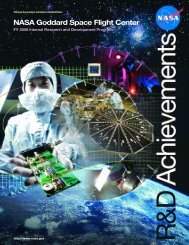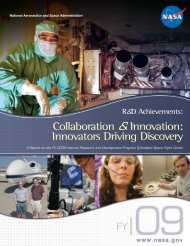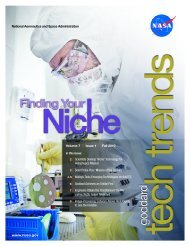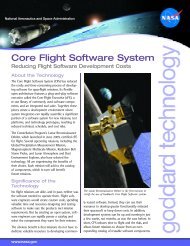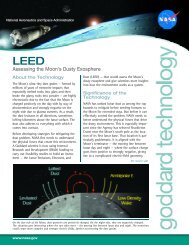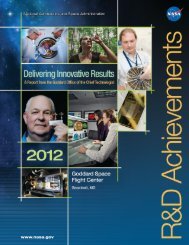Goddard Tech Trends - NASA's Goddard Technology Management ...
Goddard Tech Trends - NASA's Goddard Technology Management ...
Goddard Tech Trends - NASA's Goddard Technology Management ...
Create successful ePaper yourself
Turn your PDF publications into a flip-book with our unique Google optimized e-Paper software.
New High-Gain Antenna Speeds Up Data Delivery for Ballooncraft<br />
<strong>Tech</strong>nology Demonstrated on CREAM<br />
07<br />
Researchers who use balloons to carry their experiments<br />
to the upper-most reaches of Earth’s atmosphere now<br />
have the means to retrieve their data at greatly increased<br />
rates in near real-time — in sharp contrast to what was<br />
available to them before.<br />
The Wallops Flight Facility has developed a new highgain<br />
antenna that uses the Agency’s Tracking and Data<br />
Relay Satellite (TDRS) system to transmit scientific and<br />
housekeeping data in real-time at 100 kilobits per second.<br />
This represents a more than 10-fold increase over<br />
data rates previously achieved using omni-directional<br />
antennas.<br />
The 18-inch flat plate array antenna already has flown on<br />
the two Cosmic Ray Energetics and Mass (CREAM) payloads<br />
launched from McMurdo Station in Antarctica. The<br />
experiment, a joint effort involving several U.S. and foreign<br />
universities, measures the spectra of cosmic-ray<br />
nuclei from helium to iron. The most recent mission<br />
ended Jan. 15 after the balloon spent 28 days aloft.<br />
“The researchers got their data immediately and we<br />
were able to monitor our systems continuously and<br />
respond immediately” said Wallops Project Manager<br />
Linda Thompson, referring to the speed by which<br />
researchers received their data during CREAM 2. At 100<br />
kilobits per second, she likened the situation to what<br />
people experience when they migrate from dial-up to<br />
broadband.<br />
During the CREAM launch, data was transmitted to<br />
TDRS, which then sent it to White Sands, N.M. From<br />
there, it went to the Operations Control Center in<br />
Palestine, Texas, the Engineering Support Center at<br />
Wallops Island, Va., and on to the Science Operations<br />
Center at the University of Maryland in College Park.<br />
The antenna has a bright future, Thompson said. “It definitely<br />
could be used on aircraft.” Future enhancements<br />
will increase its data rate to upwards of 1200 kilobits per<br />
second. ◆<br />
Contact:<br />
Linda.D.Thompson@nasa.gov or 757.824.1072<br />
Brian.A.Corbin@nasa.gov or 757.824.1012<br />
<strong>Goddard</strong> <strong>Tech</strong> <strong>Trends</strong><br />
The high-gain antenna has flown on two Cosmic Ray Energetics and Mass (CREAM) payloads launched from McMurdo<br />
Station in Antarctica. The most recent mission ended Jan. 15.<br />
Volume 2 Issue 3 Spring 2006<br />
http://gsfctechnology.gsfc.nasa.gov



